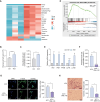DNAJC12 downregulation induces neuroblastoma progression via increased histone H4K5 lactylation
- PMID: 39716470
- PMCID: PMC12096081
- DOI: 10.1093/jmcb/mjae056
DNAJC12 downregulation induces neuroblastoma progression via increased histone H4K5 lactylation
Abstract
Neuroblastoma (NB) is the most common extracranial solid tumor in children. Despite treatment advances, the survival rates of high-risk NB patients remain low. This highlights the urgent need for a deeper understanding of the molecular mechanisms driving NB progression to support the development of new therapeutic strategies. In this study, we demonstrated that the reduced levels of DNAJC12, a protein involved in metabolic regulation, are associated with poor prognosis in NB patients. Our data indicate that low DNAJC12 expression activates glycolysis in NB cells, leading to increased lactic acid production and histone H4 lysine 5 lactylation (H4K5la). Elevated H4K5la upregulates the transcription of COL1A1, a gene implicated in cell metastasis. Immunohistochemistry staining of NB patient samples confirmed that high H4K5la levels correlate with poor clinical outcomes. Furthermore, we showed that inhibiting glycolysis, reducing H4K5la, or targeting COL1A1 can mitigate the invasive behavior of NB cells. These findings reveal a critical link between metabolic reprogramming and epigenetic modifications in the context of NB progression, suggesting that H4K5la could serve as a novel diagnostic and prognostic marker, and shed light on identifying new therapeutic targets within metabolic pathways for the treatment of this aggressive pediatric cancer.
Keywords: COL1A1; DNAJC12; biomechanical force; histone H4K5 lactylation; neuroblastoma.
© The Author(s) (2024). Published by Oxford University Press on behalf of Journal of Molecular Cell Biology, CEMCS, CAS.
Figures








Similar articles
-
ALDOC promotes neuroblastoma progression and modulates sensitivity to chemotherapy drugs by enhancing aerobic glycolysis.Front Immunol. 2025 Apr 17;16:1573815. doi: 10.3389/fimmu.2025.1573815. eCollection 2025. Front Immunol. 2025. PMID: 40313939 Free PMC article.
-
FUBP1 promotes neuroblastoma proliferation via enhancing glycolysis-a new possible marker of malignancy for neuroblastoma.J Exp Clin Cancer Res. 2019 Sep 11;38(1):400. doi: 10.1186/s13046-019-1414-6. J Exp Clin Cancer Res. 2019. PMID: 31511046 Free PMC article.
-
HNF4A-AS1/hnRNPU/CTCF axis as a therapeutic target for aerobic glycolysis and neuroblastoma progression.J Hematol Oncol. 2020 Mar 26;13(1):24. doi: 10.1186/s13045-020-00857-7. J Hematol Oncol. 2020. Retraction in: J Hematol Oncol. 2023 Aug 15;16(1):95. doi: 10.1186/s13045-023-01493-7. PMID: 32216806 Free PMC article. Retracted.
-
The roles of microRNAs in neuroblastoma.World J Pediatr. 2014 Feb;10(1):10-6. doi: 10.1007/s12519-014-0448-2. Epub 2014 Jan 25. World J Pediatr. 2014. PMID: 24464658 Review.
-
Advances in the interaction of glycolytic reprogramming with lactylation.Biomed Pharmacother. 2024 Aug;177:116982. doi: 10.1016/j.biopha.2024.116982. Epub 2024 Jun 20. Biomed Pharmacother. 2024. PMID: 38906019 Review.
Cited by
-
Single-cell transcriptomics reveals liver developmental trajectory during lineage reprogramming of human induced hepatocyte-like cells.Cell Mol Life Sci. 2025 Apr 6;82(1):139. doi: 10.1007/s00018-025-05677-x. Cell Mol Life Sci. 2025. PMID: 40188417 Free PMC article.
-
Lactylation modification in cancer: mechanisms, functions, and therapeutic strategies.Exp Hematol Oncol. 2025 Mar 8;14(1):32. doi: 10.1186/s40164-025-00622-x. Exp Hematol Oncol. 2025. PMID: 40057816 Free PMC article. Review.
-
Histone Lactylation in Diseases: Regulation by Traditional Chinese Medicine and Therapeutic Implications.Drug Des Devel Ther. 2025 Jul 29;19:6435-6459. doi: 10.2147/DDDT.S524008. eCollection 2025. Drug Des Devel Ther. 2025. PMID: 40756263 Free PMC article. Review.
References
MeSH terms
Substances
Grants and funding
LinkOut - more resources
Full Text Sources
Medical
Miscellaneous

